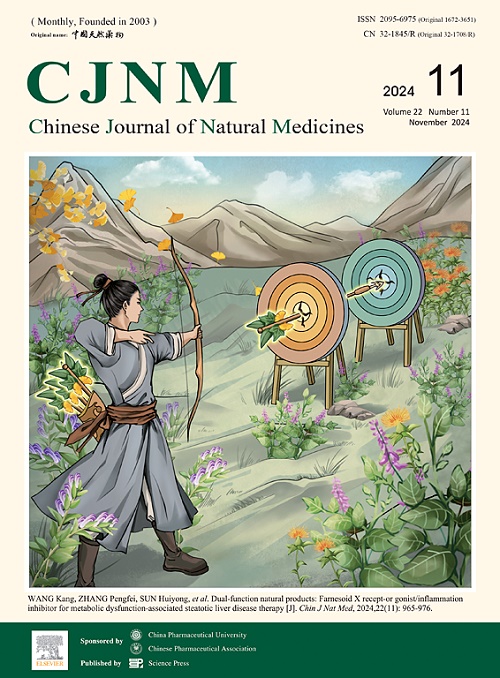Esculetin triggers ferroptosis via inhibition of the Nrf2-xCT/GPx4 axis in hepatocellular carcinoma
IF 4.9
2区 医学
Q1 INTEGRATIVE & COMPLEMENTARY MEDICINE
引用次数: 0
Abstract
Esculetin, a natural dihydroxy coumarin derived from the Chinese herbal medicine Cortex Fraxini, has demonstrated significant pharmacological activities, including anticancer properties. Ferroptosis, an iron-dependent form of regulated cell death, has garnered considerable attention due to its lethal effect on tumor cells. However, the exact role of ferroptosis in esculetin-mediated anti-hepatocellular carcinoma (HCC) effects remains poorly understood. This study investigated the impact of esculetin on HCC cells both in vitro and in vivo. The findings indicate that esculetin effectively inhibited the growth of HCC cells. Importantly, esculetin promoted the accumulation of intracellular Fe2+, leading to an increase in ROS production through the Fenton reaction. This event subsequently induced lipid peroxidation (LPO) and triggered ferroptosis within the HCC cells. The occurrence of ferroptosis was confirmed by the elevation of malondialdehyde (MDA) levels, the depletion of glutathione peroxidase (GSH-Px) activity, and the disruption of mitochondrial morphology. Notably, the inhibitor of ferroptosis, ferrostatin-1 (Fer-1), attenuated the anti-tumor effect of esculetin in HCC cells. Furthermore, the findings revealed that esculetin inhibited the Nrf2-xCT/GPx4 axis signaling in HCC cells. Overexpression of Nrf2 upregulated the expression of downstream SLC7A11 and GPX4, consequently alleviating esculetin-induced ferroptosis. In conclusion, this study suggests that esculetin exerts an anti-HCC effect by inhibiting the activity of the Nrf2-xCT/GPx4 axis, thereby triggering ferroptosis in HCC cells. These findings may contribute to the potential clinical use of esculetin as a candidate for HCC treatment.
Esculetin通过抑制Nrf2-xCT/GPx4轴在肝细胞癌中引发铁凋亡
黄芩素是一种天然的二羟基香豆素,从中草药黄芩中提取,具有显著的药理活性,包括抗癌特性。铁下垂是一种铁依赖性的调节细胞死亡形式,由于其对肿瘤细胞的致命作用而引起了相当大的关注。然而,铁下垂在escultin介导的抗肝细胞癌(HCC)作用中的确切作用仍然知之甚少。本研究在体外和体内研究了esculetin对HCC细胞的影响。结果表明,艾斯维素能有效抑制肝癌细胞的生长。重要的是,esculetin促进细胞内Fe2+的积累,通过Fenton反应导致ROS的产生增加。这一事件随后诱导脂质过氧化(LPO)并引发HCC细胞内的铁下垂。通过丙二醛(MDA)水平升高、谷胱甘肽过氧化物酶(GSH-Px)活性降低和线粒体形态破坏证实了铁下垂的发生。值得注意的是,铁下垂抑制剂铁抑素-1 (fer1)减弱了esculletin在HCC细胞中的抗肿瘤作用。此外,研究结果显示,esculetin抑制HCC细胞中Nrf2-xCT/GPx4轴信号传导。Nrf2的过表达上调下游SLC7A11和GPX4的表达,从而减轻escutin诱导的铁下垂。综上所述,本研究提示esculetin通过抑制Nrf2-xCT/GPx4轴的活性,从而引发HCC细胞铁凋亡,从而发挥抗HCC作用。这些发现可能有助于埃斯皮素作为HCC治疗的候选药物的潜在临床应用。
本文章由计算机程序翻译,如有差异,请以英文原文为准。
求助全文
约1分钟内获得全文
求助全文
来源期刊

Chinese Journal of Natural Medicines
INTEGRATIVE & COMPLEMENTARY MEDICINE-PHARMACOLOGY & PHARMACY
CiteScore
7.50
自引率
4.30%
发文量
2235
期刊介绍:
The Chinese Journal of Natural Medicines (CJNM), founded and sponsored in May 2003 by China Pharmaceutical University and the Chinese Pharmaceutical Association, is devoted to communication among pharmaceutical and medical scientists interested in the advancement of Traditional Chinese Medicines (TCM). CJNM publishes articles relating to a broad spectrum of bioactive natural products, leading compounds and medicines derived from Traditional Chinese Medicines (TCM).
Topics covered by the journal are: Resources of Traditional Chinese Medicines; Interaction and complexity of prescription; Natural Products Chemistry (including structure modification, semi-and total synthesis, bio-transformation); Pharmacology of natural products and prescription (including pharmacokinetics and toxicology); Pharmaceutics and Analytical Methods of natural products.
 求助内容:
求助内容: 应助结果提醒方式:
应助结果提醒方式:


